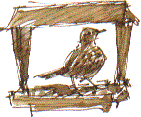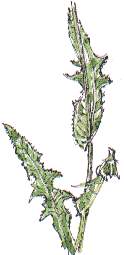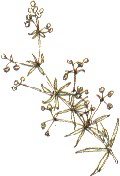 
SowthistleTuesday 25th July 2000  THERE ARE THREE common sowthistles, Smooth, Prickly and, shown here, Perennial Sowthistle. It's the tallest of the three, but there are two sure ways to identify it;
Like other sowthistles it produces a milky latex fluid when the stem is broken. This tall weed has sprung up in one or two neglected places in the garden. As I drew it, I noticed that one of the leaves (above, right) has been bent back and held in place by white silk, perhaps by a moth, or a spider.   A five-petalled blue flower has grown up in the flower tub at the foot of the bird table. It has probably sprung up from seed spilt by the birds. It seems to be Linseed, Linum usitatissimum, the variety of Common Flax which is grown for its oil rich seeds. After extraction of the oil the remaining mash is used as the basis for cattle cake. The oil is still used as the basis for artists' oil paints, and is also used in the manufacture of linoleum. From my school days, I remember the smell of the sticky oil which I used to treat my new cricket bat. My father kept in an old a Harvey's Bristol Cream bottle, with a twist of rag as a stopper, so I formed the impression that if you couldn't get linseed oil, sherry would probably make a good substitute for treating cricket bats.
A five-petalled blue flower has grown up in the flower tub at the foot of the bird table. It has probably sprung up from seed spilt by the birds. It seems to be Linseed, Linum usitatissimum, the variety of Common Flax which is grown for its oil rich seeds. After extraction of the oil the remaining mash is used as the basis for cattle cake. The oil is still used as the basis for artists' oil paints, and is also used in the manufacture of linoleum. From my school days, I remember the smell of the sticky oil which I used to treat my new cricket bat. My father kept in an old a Harvey's Bristol Cream bottle, with a twist of rag as a stopper, so I formed the impression that if you couldn't get linseed oil, sherry would probably make a good substitute for treating cricket bats. Scrambling up around the linseed is Cleavers or Goosegrass. Small hooks on the leaves help it climb amongst other plants, while the small globular seeds, covered in larger hooks, attach themselves to passing animals and to clothing, especially to hiking socks.
Scrambling up around the linseed is Cleavers or Goosegrass. Small hooks on the leaves help it climb amongst other plants, while the small globular seeds, covered in larger hooks, attach themselves to passing animals and to clothing, especially to hiking socks.
|